Skip to comments.
Here Are 5 of The Most Common Climate Change Misconceptions, Debunked (Pro Man-Made Warming)
Science Alert ^
| 09/16/2019
| Mark Maslin
Posted on 10/02/2019 2:09:39 PM PDT by SeekAndFind
The science of climate change is more than 150 years old and it is probably the most tested area of modern science. However the energy industry, political lobbyists and others have spent the last 30 years sowing doubt about the science where none really exists.
The latest estimate is that the world's five largest publicly-owned oil and gas companies spend about US$200 million each year on lobbying to control, delay or block binding climate-motivated policy.
This organised and orchestrated climate change science denial has contributed to the lack of progress in reducing global green house gas (GHG) emissions - to the point that we are facing a global climate emergency. And when climate change deniers use certain myths – at best fake news and at worse straight lies – to undermine the science of climate change, ordinary people can find it hard to see through the fog.
Here are five commonly used myths and the real science that debunks them.
1. Climate change is just part of the natural cycle
The climate of the Earth has always changed, but the study of palaeoclimatology or "past climates" shows us that the changes in the last 150 years – since the start of the industrial revolution – have been exceptional and cannot be natural. Modelling results suggest that future predicted warming could be unprecedented compared to the previous 5m years.
The "natural changes" argument is supplemented with the story that the Earth's climate is just recovering from the cooler temperatures of the Little Ice Age (1300-1850AD) and that temperatures today are really the same as the Medieval Warm Period (900–1300AD). The problem is that both the Little Ice Age and the Medieval Warming period were not global but regional changes in climate affecting north-west Europe, eastern America, Greenland and Iceland.
A study using 700 climate records showed that, over the last 2,000 years, the only time the climate all around the World has changed at the same time and in the same direction has been in the last 150 years, when over 98 percent of the surface of the planet has warmed.
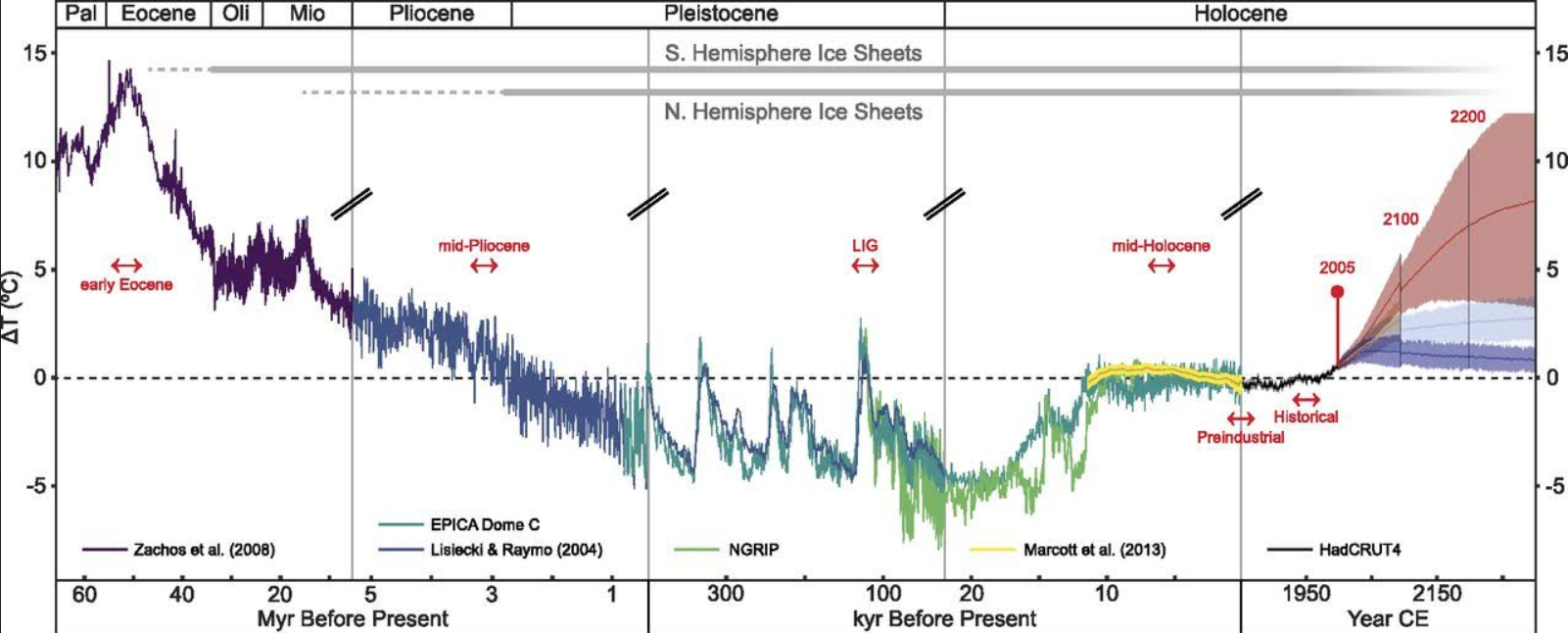 Global temperatures for the last 65m years and future warming scenarios. (Burke et al, PNAS 2018)
Global temperatures for the last 65m years and future warming scenarios. (Burke et al, PNAS 2018)
2. Changes are due to sunspots/galactic cosmic rays
Sunspots are storms on the sun's surface that come with intense magnetic activity and can be accompanied by solar flares. These sunspots do have the power to modify the climate on Earth. But scientists using sensors on satellites have been recording the amount of the sun's energy hitting Earth since 1978 and there has been no upward trend. So they cannot be the cause of the recent global warming.
Galactic cosmic rays (GCRs) are high-energy radiation that originates outside our solar system and may even be from distant galaxies. It has been suggested that they may help to seed or "make" clouds. So reduced GCRs hitting the Earth would mean fewer clouds, which would reflect less sunlight back into space and so cause Earth to warm.
But there are two problems with this idea. First, the scientific evidence shows that GCRs are not very effective at seeding clouds. And second, over the last 50 years, the amount of GCRs have actually increased, hitting record levels in recent years. If this idea were correct, GCRs should be cooling the Earth, which they aren't.
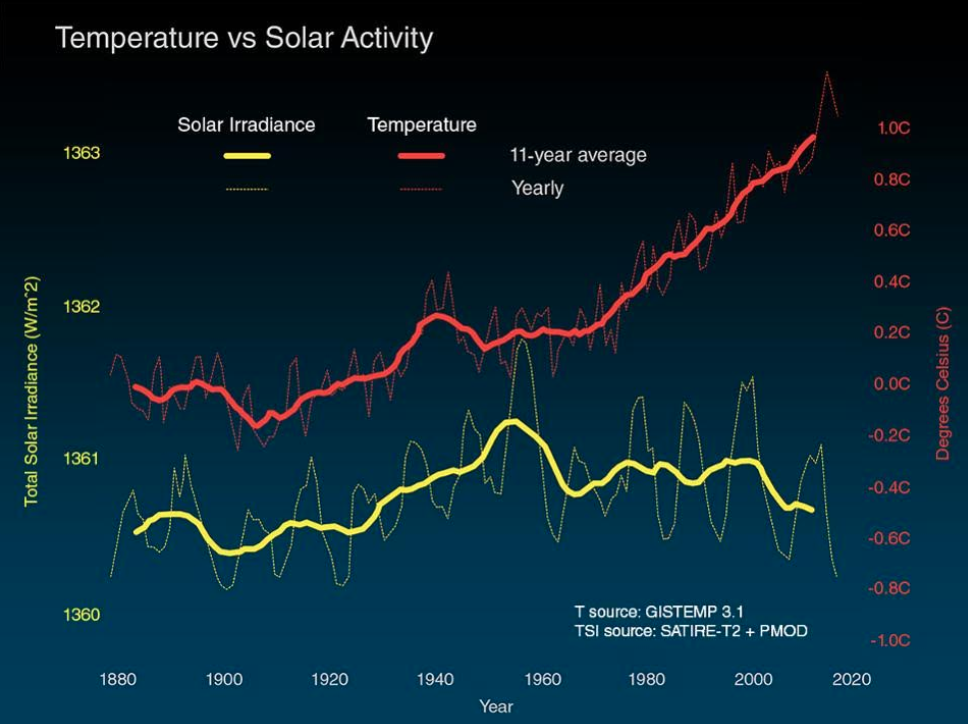 Global surface temperature (red) compared to the sun's energy received by the Earth (yellow) in watts per square metre since 1880. (NASA)
Global surface temperature (red) compared to the sun's energy received by the Earth (yellow) in watts per square metre since 1880. (NASA)
3. CO2 is a small part of the atmosphere – it can't have a large heating affect
This is an attempt to play a classic common-sense card but is completely wrong. In 1856, American scientist Eunice Newton Foote conducted an experiment with an air pump, two glass cylinders and four thermometers. It showed that a cylinder containing carbon dioxide and placed in the sun trapped more heat and stayed warmer longer than a cylinder with normal air.
Scientists have repeated these experiments in the laboratory and in the atmosphere, demonstrating again and again the greenhouse effect of carbon dioxide.
As for the "common sense" scale argument that a very small part of something can't have much of an effect on it, it only takes 0.1 grams of cyanide to kill an adult, which is about 0.0001 percent of your body weight. Compare this with carbon dioxide, which currently makes up 0.04 percent of the atmosphere and is a strong greenhouse gas. Meanwhile, nitrogen makes up 78 percent of the atmosphere and yet is highly unreactive.
4. Scientists manipulate all data sets to show a warming trend
This is not true and a simplistic device used to attack the credibility of climate scientists. It would require a conspiracy covering thousands of scientists in more than a 100 countries to reach the scale required to do this.
Scientists do correct and validate data all the time. For example we have to correct historic temperature records as how they were measured has changed. Between 1856 and 1941, most sea temperatures were measured using seawater hoisted on deck in a bucket.
Even this was not consistent as there was a shift from wooden to canvas buckets and from sailing ships to steamships, which altered the height of the ship's deck – and these changes in turn altered the amount of cooling caused by evaporation as the bucket was hoisted onto deck. Since 1941, most measurements have been made at the ship's engine water intakes, so there's no cooling from evaporation to account for.
We must also take account that many towns and cities have expanded and so that meteorological stations that were in rural areas are now in urban areas which are usually significantly warmer than the surrounding countryside.
If we didn't make these changes to the original measurements, then Earth's warming over the last 150 years would have appeared to be even greater than the change that has actually been observed, which is now about 1˚C of global warming.
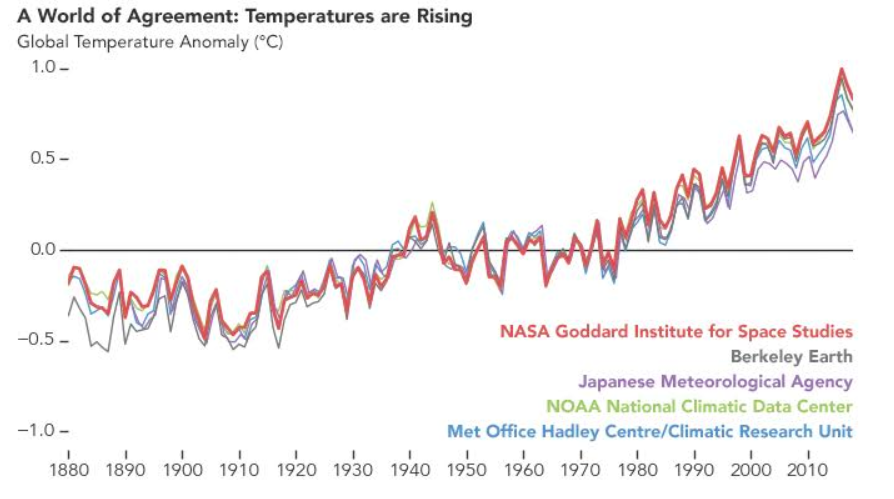 Reconstruction of global temperatures from 1880 to 2018 by five independent international groups of scientists. (NASA)
Reconstruction of global temperatures from 1880 to 2018 by five independent international groups of scientists. (NASA)
5. Climate models are unreliable and too sensitive to carbon dioxide
This is incorrect and misunderstands how models work. It is a way of downplaying the seriousness of future climate change. There is a huge range of climate models, from those aimed at specific mechanisms such as the understanding of clouds, to general circulation models (GCMs) that are used to predict the future climate of our planet.
There are over 20 major international centres where teams of some of smartest people in the world have built and run GCMs containing millions of lines of code representing the very latest understanding of the climate system. These models are continually tested against historic and palaeoclimate data as well as individual climate events such as large volcanic eruptions to make sure they reconstruct the climate, which they do extremely well.
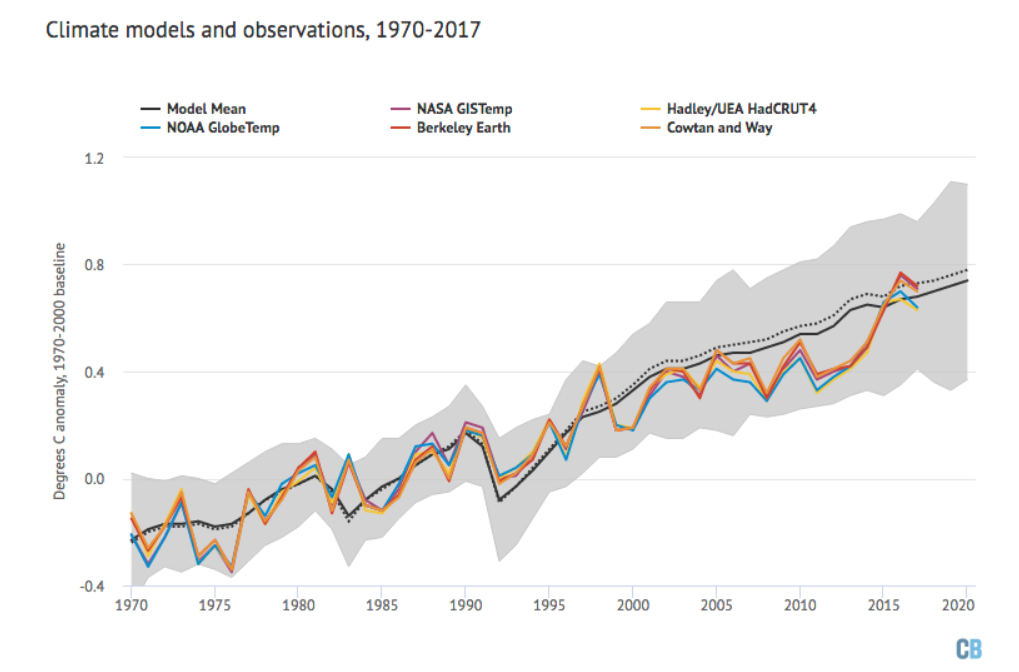 Model (black) and model range (grey) compared to observed global temperatures. (Carbon Brief/CC BY 4.0)
Model (black) and model range (grey) compared to observed global temperatures. (Carbon Brief/CC BY 4.0)
No single model should ever be considered correct as they represent a very complex global climate system. But having so many different models constructed and calibrated independently means that we can have confidence when the models agree.
Taking the whole range of climate models suggests a doubling of carbon dioxide could warm the planet by 2˚C to 4.5˚C, with an average of 3.1˚C. All the models show a significant amount of warming when extra carbon dioxide is added to the atmosphere. The scale of the predicted warming has remained very similar over the last 30 years despite the huge increase in the complexity of the models, showing it is a robust outcome of the science.
By combining all our scientific knowledge of natural (solar, volcanic, aerosols and ozone) and human-made (greenhouse gases and land-use changes) factors warming and cooling the climate shows that 100 percent of the warming observed over the last 150 years is due to humans.
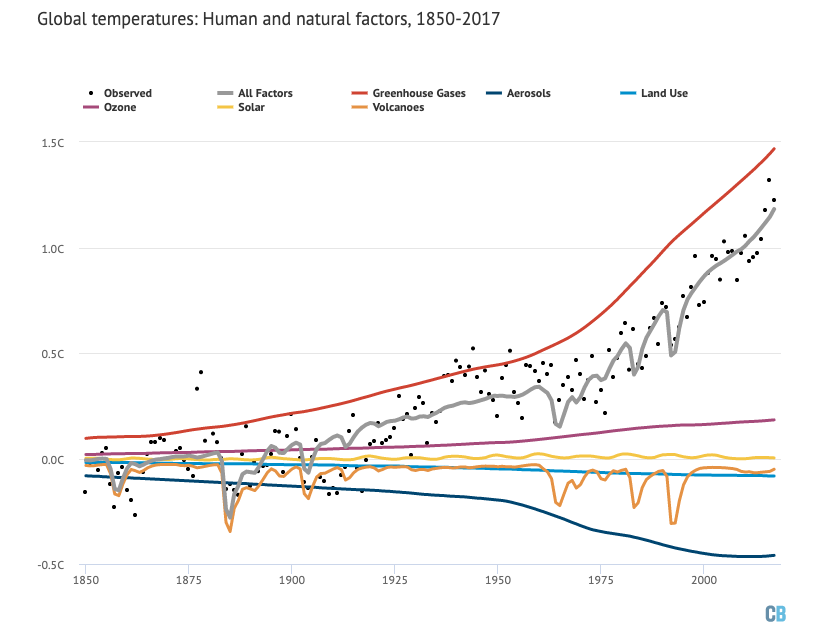 Natural and Human influences on global temperatures since 1850. Carbon Brief, CC BY
Natural and Human influences on global temperatures since 1850. Carbon Brief, CC BY
There is no scientific support for the continual denial of climate change. The Intergovernmental Panel on Climate Change (IPCC), set up by the United Nations to openly and transparently summarise the science, provides six clear lines of evidence for climate change.
As extreme weather becomes more and more common, people are realising that they do not need scientists to tell them the climate is changing – they are seeing and experiencing it first hand.
 Mark Maslin, Professor of Earth System Science, UCL.
Mark Maslin, Professor of Earth System Science, UCL.
This article originally appeared in The Conversation. It is republished here as part of ScienceAlert's partnership with Covering Climate Now, a global collaboration of more than 250 news outlets to strengthen coverage of the climate story. Read the original article.
TOPICS: Science; Weather
KEYWORDS: climatechange; globalwarming; globalwarminghoax; greennewdeal; markmaslin
Navigation: use the links below to view more comments.
first previous 1-20, 21-28 last
To: LegendHasIt; hinckley buzzard; dsrtsage; hawkaw; Paladin2; Eleutheria5; lizma2; Regulator; ...
FYI for those who missed this:
Why would we ever doubt them?
LIST OF DOOMSDAY PREDICTIONS THE CLIMATE ALARMIST GOT WRONG:
(FYI - links at bottom:)
1967: Dire Famine Forecast By 1975
1969: Everyone Will Disappear In a Cloud Of Blue Steam By 1989 (1969)
1970: Ice Age By 2000
1970: America Subject to Water Rationing By 1974 and Food Rationing By 1980
1971: New Ice Age Coming By 2020 or 2030
1972: New Ice Age By 2070
1974: Space Satellites Show New Ice Age Coming Fast
1974: Another Ice Age?
1974: Ozone Depletion a ‘Great Peril to Life
1976: Scientific Consensus Planet Cooling, Famines imminent
1980: Acid Rain Kills Life In Lakes
1978: No End in Sight to 30-Year Cooling Trend
1988: Regional Droughts (that never happened) in 1990s
1988: Temperatures in DC Will Hit Record Highs
1988: Maldive Islands will Be Underwater by 2018 (they’re not)
1989: Rising Sea Levels will Obliterate Nations if Nothing Done by 2000
1989: New York City’s West Side Highway Underwater by 2019 (it’s not)
2000: Children Won’t Know what Snow Is
2002: Famine In 10 Years If We Don’t Give Up Eating Fish, Meat, and Dairy
2004: Britain will Be Siberia by 2024
2008: Arctic will Be Ice Free by 2018
2008: Climate Genius Al Gore Predicts Ice-Free Arctic by 2013
2009: Climate Genius Prince Charles Says we Have 96 Months to Save World
2009: UK Prime Minister Says 50 Days to ‘Save The Planet From Catastrophe’
2009: Climate Genius Al Gore Moves 2013 Prediction of Ice-Free Arctic to 2014
2013: Arctic Ice-Free by 2015
2014: Only 500 Days Before ‘Climate Chaos’
1968: Overpopulation Will Spread Worldwide
1970: World Will Use Up All its Natural Resources
1966: Oil Gone in Ten Years
1972: Oil Depleted in 20 Years
1977: Department of Energy Says Oil will Peak in 90s
1980: Peak Oil In 2000
1996: Peak Oil in 2020
2002: Peak Oil in 2010
2006: Super Hurricanes!
2005 : Manhattan Underwater by 2015
1970: Urban Citizens Will Require Gas Masks by 1985
1970: Nitrogen buildup Will Make All Land Unusable
1970: Decaying Pollution Will Kill all the Fish
1970s: Killer Bees!
Sorry, Experts… Sorry, Scientific Consensus… Only a fool comes running for the 42nd cry of wolf.
List Climate ‘experts’ got right:
;
ZERO
above from links:
https://www.breitbart.com/environment/2019/09/20/nolte-climate-experts-are-0-41-with-their-doomsday-predictions/
https://cei.org/blog/wrong-again-50-years-failed-eco-pocalyptic-predictions
21
posted on
10/02/2019 8:56:02 PM PDT
by
GOPJ
(<img src=https://i.imgur.com/WjoG6dB.png width=500> The American press sucks...)
To: GOPJ
They were predicting overpopulation 500 years ago, too. Google Malthus.
22
posted on
10/02/2019 9:59:24 PM PDT
by
Eleutheria5
(If you are not prepared to use force to defend civilization, then be prepared to accept barbarism.)
To: SeekAndFind
A mile of ice was over much of North America some 10,000 years ago.
We did not melt it.
23
posted on
10/02/2019 11:08:42 PM PDT
by
minnesota_bound
(homeless guy. He just has more money....)
To: SeekAndFind; hinckley buzzard; dsrtsage; FreedomOfExpression; SunkenCiv; NobleFree; olezip
Rule #1: Any negative occurrence can be blamed on Climate Change
The problem is that both the Little Ice Age and the Medieval Warming period were not global but regional changes in climate affecting north-west Europe, eastern America, Greenland and Iceland.
Such claims have now been sharply contradicted by the most comprehensive study yet of global temperature over the past 1,000 years. A review of more than 240 scientific studies has shown that today's temperatures are neither the warmest over the past millennium, nor are they producing the most extreme weather - in stark contrast to the claims of the environmentalists.
The review, carried out by a team from Harvard University, examined the findings of studies of so-called "temperature proxies" such as tree rings, ice cores and historical accounts which allow scientists to estimate temperatures prevailing at sites around the world. The findings prove that the world experienced a Medieval Warm Period between the ninth and 14th centuries with global temperatures significantly higher even than today. They also confirm claims that a Little Ice Age set in around 1300, during which the world cooled dramatically. Since 1900, the world has begun to warm up again - but has still to reach the balmy temperatures of the Middle Ages. - https://www.telegraph.co.uk/news/uknews/1426744/Middle-Ages-were-warmer-than-today-say-scientists.html
Geologic Evidence of Recurring Climate Cycles and Their Implications for the Cause of Global Climate Changes—The Past is the Key to the Future Don J. Easterbrook, in Evidence-Based Climate Science, 2011
The Medieval Warm Period (MWP) was a time of warm climate from about 900–1300 AD, when global temperatures were somewhat warmer than at present. Temperatures in the GISP2 ice core were about 2°F (1°C) warmer than modern temperatures (Fig. 8.14). The effects of the warm period were particularly evident in Europe, where grain crops flourished, alpine tree lines rose, many new cities arose, and the population more than doubled. - https://www.sciencedirect.com/topics/earth-and-planetary-sciences/medieval-warm-period
And further back, based on the calculations that assign an extreme age to the earth, then the earth was far warmer during the
Middle Miocene, 16 million years ago, when our ancestors were apes. Temperatures then were about 5 to 8ºC warmer not 2º, and sea levels were some 40 meters (130 feet) or more higher, not the 1.5 feet (half a meter) anticipated at the end of this century by the 2013 IPCC report.
Places as far afield as East Coast USA, the Pacific Northwest, Western China, Patagonia, Central Asia, and the Atacama in South America, all became much wetter, causing a global uptick in erosion. The result was a general expansion and densification of forests. Remarkably, there’s no sign of deserts either in North Africa or Asia, where today we have the Sahara and Gobi deserts.
That widespread wetting and greening is at odds with projected changes for our future, where areas that are currently wet are projected to get wetter, but dry areas are expected to get dryer. The difference may reflect the abrupt and unfinished nature of our climate change compared to the much slower Miocene change.
Even though landscapes right before the MMCO were already extensively forested (unlike today’s, which reflect interglacial habitat deforestation by humans for millennia), the Miocene warming still produced clear changes in vegetation around the world, preserved in fossils, especially fossil pollen.
Across much of Europe, subtropical vegetation replaced cool-adapted plants, and dense swamp-forests resembling modern Louisiana clogged coasts and estuaries in Denmark and Germany (the European shoreline was 120 miles inland from today’s coast). Those swamps accumulated brown coal that now fuels about a quarter of German electricity generation. Spain bucked the wet trend by having a hot, dry climate in the south, and a warm and wetter climate in the north just like today, with long dry seasons.
Nearer the equator, early elephants and antelope roamed Arabia’s grassy, wet interior, while North Africa was lushly forested where Saharan sand dunes drift today. Apes spread across the forested planet, and it was about that time when great apes (our ancestors) diverged from other apes. - https://arstechnica.com/science/2018/06/are-past-climates-telling-us-were-missing-something/
And which hyper-extreme warming is invoked by Climate Change activists:
But the most striking feature of this early age of mammals is that it was almost unbelievably hot, so hot that around 50 million years ago there were crocodiles, palm trees, and sand tiger sharks in the Arctic Circle. On the other side of the blue-green orb, in waters that today would surround Antarctica, sea-surface temperatures might have topped an unthinkable 86 degrees Fahrenheit, with near-tropical forests on Antarctica itself. There were perhaps even sprawling, febrile dead zones spanning the tropics, too hot even for animal or plant life of any sort. More Stories
This is what you get in an ancient atmosphere with around 1,000 parts per million (ppm) of carbon dioxide. If this number sounds familiar, 1,000 ppm of CO2 is around what humanity is on pace to reach by the end of this century. That should be mildly concerning.
If we didn't make these changes to the original measurements, then Earth's warming over the last 150 years would have appeared to be even greater than the change that has actually been observed, which is now about 1˚C of global warming. - https://www.theatlantic.com/science/archive/2018/08/earths-scorching-hot-history/566762/
Which if real, is actually beneficial overall, as will the predicted 2˚C or more, at least where we live.
Warmer Days and Longer Lives Thomas Gale Moore Senior Fellow Hoover Institution Stanford University
History demonstrates that warmer is healthier. Since the end of the last Ice Age, the earth has enjoyed two periods that were warmer than the twentieth century. Archaeological evidence shows that people lived longer, enjoyed better nutrition, and multiplied more rapidly than during epochs of cold.
That Ice Age ended about 12,000 to 10,000 years ago when the glaciers covering much of North America, Scandinavia and northern Asia began to retreat to approximately their current positions. In North America the glacial covering lasted longer than in Eurasia because of topographical features that delayed the warming. Throughout history warming and cooling in different regions of the world have not correlated exactly because of the influence of such factors as oceans, mountains, and prevailing winds.
As the earth warmed with the waning of the Ice Age, the sea level rose as much as 300 feet; hunters in Europe roamed through modern Norway; agriculture developed in the Middle East, the Far East and the Americas. By 7,000 years ago and lasting for about four millenniums, the earth was more clement than today, perhaps by 4deg. Fahrenheit, about the average of the various predictions for global warming from a doubling of CO2. Although the climate cooled a bit after 3000 B.C., it stayed relatively warmer than the modern world until sometime after 1000 B.C., when chilly temperatures became more common. During the four thousand warmest years, Europe enjoyed mild winters and warm summers with a storm belt far to the north. Rainfall may have been 10 to 15 percent greater than now. Not only was the country less subject to severe storms, but the skies were less cloudy and the days, sunnier.
From around 800 A.D. to 1200 or 1300, the globe warmed again considerably and civilization prospered. This warm era displays, although less distinctly, many of the same characteristics as the earlier period of clement weather. Virtually all of northern Europe, the British Isles, Scandinavia, Greenland, and Iceland were considerably warmer than at present. The Mediterranean, the Near East, and North Africa, including the Sahara, received more rainfall than they do today. During this period of the High Middle Ages, most of North America also enjoyed better weather. In the early centuries of the epoch, China experienced higher temperatures and a more clement climate. From Western Europe to China, East Asia, India, and the Americas, mankind flourished as never before.
This prosperous period collapsed at the end of the thirteenth century with the advent of the "Mini Ice Age" which, at its most frigid, produced temperatures in central England for January about 4.5deg.F colder than today. Although the climate fluctuated, periods of cold damp weather lasted until the early part of the nineteenth century. During the chilliest decades, 5 to 15 percent less rain fell in Europe than does normally today; but, due to less evaporation because of the low temperatures, swampy conditions were more prevalent. As a result, in the fourteenth century the population explosion came to an abrupt halt; economic activity slowed; lives shortened as disease spread and diets deteriorated. - https://web.stanford.edu/~moore/history_health.html
ature revealed just how much CO₂ increases have greened the Earth over the past three decades. Because CO₂ acts as a fertilizer, as much as half of all vegetated land is persistently greener today. This ought to be a cause for great joy. Instead, the BBC focused on warning that the paper shouldn’t make us stop worrying about global warming, with threats like melting glaciers and more severe tropical storms. Many other major news outlets did not even report on the study.
We have known for decades that increasing CO₂ and precipitation from global warming will make the world much greener – by the end of the century, it is likely that global biomass will have increased by forty percent.
Similarly, we know that many more people die from cold than from heat. The biggest study on heat and cold deaths, published last year in Lancet, examined more than 74 million deaths from 384 locations in 13 countries from cold Sweden to hot Thailand. The researchers found that heat causes almost one-half of one percent of all deaths, while more than 7 percent are caused by cold. - https://www.telegraph.co.uk/news/2016/05/05/no-one-ever-says-it-but-in-many-ways-global-warming-will-be-a-go/
Why climate change is good for the world Don't panic! The scientific consensus is that warmer temperatures do more good than harm Matt Ridley - https://www.spectator.co.uk/2013/10/carry-on-warming/
24
posted on
10/03/2019 6:07:36 AM PDT
by
daniel1212
( Trust the risen Lord Jesus to save you as a damned and destitute sinner + be baptized + follow Him)
To: Eleutheria5
Malthus and Ehrlich made the same mistake... didn’t take into account improved farming...
25
posted on
10/03/2019 7:04:44 AM PDT
by
GOPJ
(<img src=https://i.imgur.com/WjoG6dB.png width=500> The American press sucks...)
To: GOPJ
And Foote tried to extrapolate from a couple of tubes full of gas something as complex and multi-factored as the global climate. One thing I better warn them: Keep the hell away from fermented beverages. You want to believe that cows fart, and that cow’s alleged ability to fart will one day destroy the world, feel free. There’s always chicken. But fermentation creates carbon dioxide like gang-busters. Sometimes it’s trapped in the beverage to make the bubbles, like beer and champagne, and sometimes it just goes out into the atmosphere. That’s how it works. And you had damned well better keep away from that with your green big deal. You attempt to deprive deplorables of beer, wine and hard liquor, and we will come for you.
26
posted on
10/03/2019 9:33:42 AM PDT
by
Eleutheria5
(If you are not prepared to use force to defend civilization, then be prepared to accept barbarism.)
To: SeekAndFind
Modelling results suggest . . .OK, I know where this is going.
27
posted on
10/03/2019 10:10:17 AM PDT
by
Oatka
To: daniel1212; AdmSmith; AnonymousConservative; Arthur Wildfire! March; Berosus; Bockscar; ...
28
posted on
10/03/2019 12:26:52 PM PDT
by
SunkenCiv
(Imagine an imaginary menagerie manager imagining managing an imaginary menagerie.)
Navigation: use the links below to view more comments.
first previous 1-20, 21-28 last
Disclaimer:
Opinions posted on Free Republic are those of the individual
posters and do not necessarily represent the opinion of Free Republic or its
management. All materials posted herein are protected by copyright law and the
exemption for fair use of copyrighted works.
FreeRepublic.com is powered by software copyright 2000-2008 John Robinson
 Global temperatures for the last 65m years and future warming scenarios. (Burke et al, PNAS 2018)
Global temperatures for the last 65m years and future warming scenarios. (Burke et al, PNAS 2018) Global surface temperature (red) compared to the sun's energy received by the Earth (yellow) in watts per square metre since 1880. (NASA)
Global surface temperature (red) compared to the sun's energy received by the Earth (yellow) in watts per square metre since 1880. (NASA) Reconstruction of global temperatures from 1880 to 2018 by five independent international groups of scientists. (NASA)
Reconstruction of global temperatures from 1880 to 2018 by five independent international groups of scientists. (NASA) Model (black) and model range (grey) compared to observed global temperatures. (Carbon Brief/CC BY 4.0)
Model (black) and model range (grey) compared to observed global temperatures. (Carbon Brief/CC BY 4.0) Natural and Human influences on global temperatures since 1850. Carbon Brief, CC BY
Natural and Human influences on global temperatures since 1850. Carbon Brief, CC BY![]() Mark Maslin, Professor of Earth System Science, UCL.
Mark Maslin, Professor of Earth System Science, UCL.